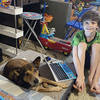

Little fingers dance across keyboards and nimbly swipe touchscreens with dizzying ease: it’s enough for any parent to ask, “Is my kid smarter than I am?”
In reality, it’s just the wave of the future, with the COVID-19 pandemic pushing the timeline forward for many Texas schools. Blanco County school leadership, and parents who have picked the remote option for their children, are adapting to these new ways of learning.
“Our teachers are superheroes: they’re managing online learners and in-person learners at the same time,” said Collin Gaskamp, instructional technology specialist for Blanco ISD. “It’s been overwhelming for them, but they’re dedicated to helping each child excel.”
The virtual life
Just two of those children are Blanco Elementary School students Khalen and Zeke. Around 30 percent of the district’s elementary school students are learning from home.
The brothers are thriving in the virtual learning arena, said their mother, Rachelle Willgren.
“My kids love remote learning but they miss seeing their friends,” Willgren said. “They both had a say in our family discussion and decision.”
With at-home learning, the kids get way more than the traditional “Three R’s.”
“Khalen is only 7 and he’s been able to take computer programming, art, and Spanish classes online through various programs; Zeke is 5 and he’s been able to learn more about paleontology, art, and bugs, all while getting his public-school education,” Willgren said. “The distance learners are learning the exact same things as their friends in the classroom, just in a slightly different format.”
The kids have adapted to the scenario, balancing textbooks, manipulatives and online resources.
“I like getting to learn extra things because I like to learn,” Zeke said. “I like writing in my journal every morning and having extra time to read. I like having extra snuggles and time to be alone when I need it. I also like getting to play outside and extra snack time!”
Khalen also is making the most of it.
“I like learning on a computer and having more time to read and write my own things,” he said.
Overall, Willgren is satisfied with the district’s handling of virtual learning.
“We feel very supported, and missed!” she said. “The teachers are doing an incredible job of staying in touch and answering questions. It’s just going to get better once we get into the full swing of things. There’s been the expected frustrations of login issues and online snags to work out, which happen in the classroom, too.”
The family is adjusting.
“We’re settling into a routine and finding a schedule so to balance working full-time and managing the instruction of the kids,” Willgren said.
Advantages and disadvantages
The district’s tech department invested time over the summer helping teachers get used to teaching via Zoom, a video conferencing app, and other tech tools.
“We’ve had Google Classroom for a long time, but not all teachers used it,” Gaskamp said. “Now everyone has seen how powerful it is.”
Teachers use programs such as Google Meet or Screencastify to record their lessons, which can be helpful for learners in and out of the classroom.
“All students have access to our Learning Management System, so that if a student in the classroom is struggling with a topic, they can go back and watch the lesson again,” she said.
However, humans by nature seek connections, which can be challenging through a screen.
“It’s not the same as having interactions face to face,” Gaskamp said.
Finding other kinds of connections can be challenging, also.
“In our rural area, the internet service and even cell coverage for hotspots are minimal,” she said.
Since the pandemic shut down schools in March, the district made substantial investments in technology and now has a one-to-one program: one device in the hands of every student.
“In March, one of our biggest struggles was getting a device for every student because we only had about 530 Chromebook devices for 1,000 students,” Gaskamp said.
The district ordered 500 more devices and hot spots to help bridge the gap, but the hot spots are on backorder. The district is looking into ordering more.
“Most of the families that chose at-home learning have internet but it can be spotty at times,” she said. “The network is supporting all of our users adequately but we’re installing some new Wi-Fi access points.”
Gaskamp said that the district already was in the process of replacing teachers’ desktop computers with laptops, a process that was completed in January.
“Over the last 3 years we’ve enhanced our network and increased internet bandwidth,” she said. “If these two pieces of that 3-year plan had not been completed, we’d be facing a much larger problem and challenge with remote teaching.”
Willgren and Khalen will always remember his first lost tooth of the school year.
“We were able to send a photo to his classroom’s SeeSaw journal--the main communication method for assignments—and the next morning he got a voice message reply from his entire class saying ‘Congratulations!’ Willgren said. “It totally made his day and made him feel like a part of the class.”



